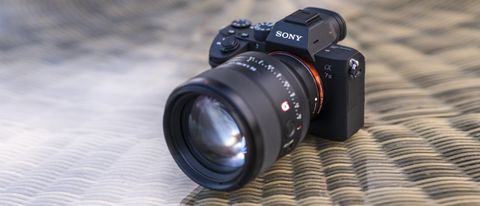Miksi TechRadar voi luottaa
Build and handling
- Design identical to the Alpha A7R III
- Features a multi-selector joystick and AF-On button
- Dust- and weather-sealed
The Alpha A7 III has the same body as the Alpha A7R III, which means the new camera gains the same refinements to the control layout as its higher-resolution stablemate.
So while there's no dedicated drive mode dial or focus mode selector, as we've seen on the Alpha A9, the Alpha A7 III does benefit from the addition of a multi-selector joystick.
As we found with the A7R III, the joystick greatly improves the handling of the camera, with AF point selection that much quicker out in the field. Another bit of good news is the arrival of a dedicated AF-On button on the rear of the Alpha A7 III, making back-button focusing much easier. The button is positioned nicely, although we wouldn't mind it being a little more pronounced so it's easier to press.
All the Alpha A7 III's major buttons and dials are sealed from the elements to protect against dust and moisture
The rear scroll wheel is raised away from the body a bit more than on the Alpha A7 II, and it's less likely that you'll inadvertently change a setting thanks to there being slightly more resistance in its movement.
Another welcome touch taken from the A7R III is that the eye sensor is now deactivated when the rear screen is pulled away from the body. This means it's possible to shoot waist-level images without the feed cutting out and rather unhelpfully swapping to the EVF.





The body is a touch thicker than the A7 II as well, but it feels more satisfying to hold thanks to a refined grip, and the overall feel of the camera is very good thanks to a predominantly magnesium construction that virtually mirrors that of the Alpha A7R III. It's not quite the same though, as while the back panel of the A7R III is forged from magnesium, the A7 III instead uses plastic.
As you'd expect for a camera at this price, all the major buttons and dials are sealed against the elements to protect from dust and moisture. That said, as we found with the Alpha A9, the three doors on the side of the Alpha A7 III that offer access to the camera's various terminals don't appear to have quite the level of sealing we'd hope to see; they feel a little flimsy, while there don't appear to be rubber seals. You'll definitely want to double check that these are securely shut when shooting in less-than-perfect conditions.
While the Alpha A7 III's menu is as incredibly comprehensive as its predecessor's, the new color-coded system is a bit easier to navigate, although once you've set up the various custom buttons on the camera and taken advantage of the various body-mounted controls, you should only have to dive into the menu on the odd occasion.
Autofocus
- Same 693-point AF system as the Alpha A9
- 93% coverage
- Focuses down to -3EV
It's not often that you see a manufacturer take the AF system from its flagship camera and put it in a camera less than half the price, but that's exactly what Sony has done with the Alpha A7 III.
The Alpha A7 III gets the same, brilliant, 693-point phase-detect AF system as the Alpha A9.
This is a huge step up from the rather clunky 117-point system in the Alpha A7 II, with the new system offering an impressive 93% coverage across the frame, with an additional 425 contrast-detect points to aid focus; for good measure it can also focus in light levels as low as -3EV.
The Alpha A7 III sports a wide variety of AF modes, enabling you to make things as simple or as advanced as you need depending on the shooting situation.

Click here to see the full-size image

Click here to see the full-size image
As we found with the Alpha A9, with the A7 III in continuous AF mode and set to one of its more sophisticated AF modes, such as Lock-on: Flexible Spot M, the tracking performance is very impressive. While it can on occasion get tricked by fast and erratically moving subjects, overall it's an incredibly impressive and reliable system. If you're planning to shoot action with the Alpha A7 III, don't be in any doubt that this is one of the best systems out there for tracking your subject, and it's very exciting for a camera at this price point.
The Alpha A7 III also gets Sony's latest Eye AF focusing mode. This is a great feature for portrait and social photographers, as with this activated the system will continuously track and focus on your subject's eye, even if they look down or away from the camera momentarily.
Current page: Build, handling and AF
Edellinen sivu Introduction and key features Seuraava sivu Performance and image qualityPhil Hall is an experienced writer and editor having worked on some of the largest photography magazines in the UK, and now edit the photography channel of TechRadar, the UK's biggest tech website and one of the largest in the world. He has also worked on numerous commercial projects, including working with manufacturers like Nikon and Fujifilm on bespoke printed and online camera guides, as well as writing technique blogs and copy for the John Lewis Technology guide.
